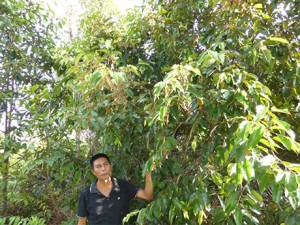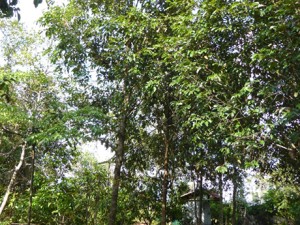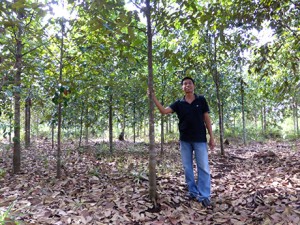Shorea balangeran wood



Source plants
- scientific name
- Shorea balangeran (Korth.) Burck.
Syn.: Hopea balangeran Korth., Parahopea balangeran Heim,
Parashorea balangeran (Korth.) Merr.,
Shorea balangeran var. angustifolia Boerl. - general name
-
Balangeran, Kahui
Borneo: Balangiran, Kahoi, Kawi, Kelandan, Kelansau, Lempung nasi.
Sumatra: Melangir (Bangka, Belitung).
- overview
-
Shorea balangeran is a medium to tall broad leaved tree that grows to 30 m in height and belongs to the family Dipterocarpaceae. Its buttress roots are usually around 1.2 m long. It is a very dense wood of high durability, which is in demand as building material. It is naturally distributed in Kalimantan Island and its surrounding small islands such as Banka and Belitung Islands. This species can grow in hard soil and peat bogs of organic soil. In the peat bog forests in Central Kalimantan, it is naturally distributed at the margin of a dome structure, where the water level is the highest. It is registered as Critically Endangered, designated by the International Union for the Conservation of Nature and Natural Resources (IUCN), and highly likely to become extinct in the wild in the immediate future.
Shorea balangeran grows relatively fast in the Dipterocarpaceae family, and has pioneering ecological characteristics, being resistant to strong light and high temperature in open land. In addition, it is highly resistant to water-logged soil and can survive for at least a month even when the tree body is completely submerged. Also, it can be coppiced if the above-ground part gets lost due to a ground surface fire, making it comparatively resistant to fires. Furthermore, it is easy to collect seeds from Shorea balangeran as it blooms and bears fruits every year. It is not possible to store the seeds for a long period of time as they are non-dormant, but if they are sown within ten days, germination and later survival rates are high, which makes it easy to produce seedlings. In planting of seedlings, handling is easy as it is possible to transfer and plant them uncovered. The percentage of rooting is as high as 80%. Thanks to all these characteristics, it is possible to use as an afforestation species. In addition, it can be cultivated by direct seeding so that saving of labor and cost is possible. It is expected to grow up to around 30 cm in breast-height diameter in 15-20 years, and for timber production, a management plan with a cutting cycle of 15-20 years can be made.
Product characteristics
- use
- Building materials (materials for pillars and boards)
- area
- Peat bogs in Indonesia (Kalimantan, Bangka, and Belitung)
- overview
-
Shorea balangeran is an excellent wood, which is called red meranti in classification of wood distribution. It is a heavy wood with density of 730-990 kg/m3 when moisture content is 15%. Its international trade price is in the highest rank. In Central Kalimantan, Indonesia, it has traditionally been used as building material such as pillar and board materials in local communities. In Kalimantan, Eusideroxylon zwageri, one of the most durable woods, grows only in hard soil, but Shorea balangeran can grow in hard soil and peat bogs of organic soil and is the second most durable wood following Eusideroxylon zwageri.
Trade price of shorea balangeran wood in Kalimantan
Shorea balangeran is in demand as building material. At the time of the field survey conducted in 2015, a four-meter pillar material of a small tree, whose diameter is 15-20 cm, cultivated from natural forest was sold at about 500 yen per log on the roadside of a main highway in the surrounding area of Palangkaraya in Central Kalimantan Province. At a small- to medium-sized lumber mill, the buying price of a medium tree with a diameter of 30 cm was about 7,000 yen/m3, CIF at the factory. The CIF price of Shorea balangeran was expected to be about 16,000/m
3 as the FOB price of the woods produced in bogs including Shorea balangeran was about 12,000/m3 when transferring to plywood mills in other areas, such as Java and South Kalimantan Province. The profitability of a Shorea balangeran planting project was analyzed using the buying price of 16,000 yen/m3, CIF at plywood factories, on the assumption that it is possible to crop 800 logs/ha of woods with breast-height diameter of 30 cm in a 20-year cutting cycle. As a result, it was calculated that it will exceed the profitable line and the possibility of commercialization was indicated.
Issues to be addressed
Generally, peat bogs are not suitable for the growth of plants as they are acid and oligotrophic, and the ground-water level is high. Shorea balangeran, which is resistant to peat bogs and grows in a comparatively speedy manner, is promising as an afforestation species to produce building materials. Going forward, profitability of the business will be increased through elite tree selection and development of cultivation technologies by direct seeding.
However, in the vast devastated bogs of Sumatra and Kalimantan in Indonesia, large-scale forest fires have arisen due to factors such as aridification from deforestation and farmland development, and slash and burn agriculture by local residents and spreading fire from palm plantation burning. In afforestation commercialization, it is necessary to reduce the fire risks. In concessions managed by companies, appropriate water level management, and fire prevention and firefighting measures are important. On the land whose user rights are held by local residents, the issue is that the local residents plant trees with firm ownership to give them an incentive to save the planted trees from fires. Producing timber using Shorea balangeran in peat bogs as well as reforestation and conservation of remaining natural trees is not possible without reducing fire risks in such ways.
According to precedent, in Java, afforestation of Paraserianthes falcataria, which has market value as plywood, on private land has become popular. If there is a certain level of profitability in the afforestation business of Shorea balangeran in peat bogs as above, there is the possibility that afforestation by the residents will proceed explosively.
- references
-
- Suryanto, Tjuk Sasmito and Endang Sabitri ed. (2012) Budidaya Shorea balangeran di lahan gambut. Balai Penelitian Kehutanan Banjarbaru, Badan Penelitian dan Pengembangan Kehutanan, Kementrian Kehutanan. (in Indonesian)
- PROCEA (1994) I. Soerianegara and R. H. M. J. Lemmens ed. Shorea balangeran (Korth.) Burck. Plant Resources of South-East Asia No.5, (1) Timber trees: Major commercial timber. 392-393, Bogor Indonesia
- Pl@ntUse. Shorea balangeran (PROSEA) http://uses.plantnet-project.org/en/Shorea_balangeran_(PROSEA)
- The IUCN Red List of Threatened SpeciesTM Shorea balangeran. http://www.iucnredlist.org/details/33103/0
- Plants of Southeast Asia Shorea balangeran (Korth.) Burck, Ann. Jard. Bot. Btzg. 6 (1887) http://www.asianplant.net/Dipterocarpaceae/Shorea_balangeran.htm


